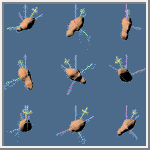|
COMETS EARTH JUPITER KUIPER BELT MARS MERCURY METEORITES NEPTUNE OORT CLOUD PLUTO SATURN SOLAR SYSTEM SPACE SUN URANUS VENUS ORDER PRINTS
PHOTO CATEGORIES SCIENCEVIEWS AMERICAN INDIAN AMPHIBIANS BIRDS BUGS FINE ART FOSSILS THE ISLANDS HISTORICAL PHOTOS MAMMALS OTHER PARKS PLANTS RELIGIOUS REPTILES SCIENCEVIEWS PRINTS
|
Related Document
Download Options
This image shows the non-principal-axis spin state of asteroid 4179 Toutatis at one-day intervals (read from left to right, top to bottom). The red, green, and blue axes are the principal axes of inertia; the magenta axis is the angular momentum vector; the yellow axis is the spin vector. Unlike the vast majority of solar system objects that have been studied, Toutatis does not spin about a single axis, that is, it has no fixed north and south poles. Instead, its spin vector traces a curve around the asteroid's surface once every 5.41 days. During this time the object rotates once about its long axis, and every 7.35 days, on average, the long axis precesses about the angular momentum vector. The combination of these two motions with different periods give Toutatis its bizarre "tumbling" rotation. (Courtesy Scott Hudson, Washington State University) |
